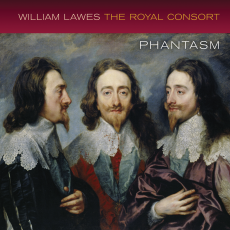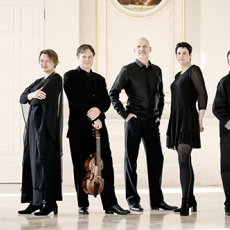Phantasm - Lawes: The Royal Consort - The Viol
William Lawes's five- and six-part consort sets 'to the organ' are the high point literally for the treble players...) of many playing sessions, but his four-part repertory is probably less well explored, even though some of it has been available since the 1950s and 1960s in editions by Carl Dolmetsch, Layton Ring and Gordon Dodd. A complete collection, meticulously edited by David Pinto, was published by Fretwork Editions in 1995, entitled The Royall Consort (old version).
On this generous pair of CDs (144 minutes' music in total) Phantasm perform 62 four-part dances from the 'old version' (mostly almans, corants and sarabands but with a few majestic pavans) as well as one five-part 'organ' set (in F major) and two of the six-part sets (C minor and C major) which they did not have room for on their previous Lawes recording. It is wonderful to have all this music accessible on CD, though it makes for a gargantuan Lawesian feast, probably best digested over a number of sittings rather than in just one go!
The Royal[l] Consort has a complex background and a large number of sources, all fully discussed by David Pinto in his edition, with further commentary in his 1995 book For ye Violls. There is more recent discussion in John Cunningham's 2010 monograph The Consort Music of William Lawes. These raise questions about the relationship between the four-part dances recorded here and other versions of them made by Lawes for two violins, two bass viols and two theorbos, also edited by Pinto as The Royall Consort (new version). It is not at all clear from the surviving sources which version actually came first, but most commentators seem to agree that the 'new' version is an expansion of the 'old' one, even though in some cases both versions appear to have been created at much the same time. Laurence Dreyfus, in his often provocative 13-page insert note, certainly assumes the 'old' came first and excoriates Lawes for producing 'a measurably worse piece of music' in the 'new' versions.
Dreyfus's first complaint is that in taking Lawes's original tenor and bass parts and sharing them out between two criss-crossing bass viols that often indulge in added counterpoint and divisions, he overcomplicated the texture. This surely is a matter of opinion and taste, as well as function: what if Charles I, himself no slouch on the bass viol, had commanded Lawes to write an exciting part for him to play? It is interesting that having criticised the 'new' bass parts, Phantasm actually adopt the more florid version for the opening of Paven (55) rather than playing the comparatively static part preserved in the 'old' version.
Dreyfus then accuses Lawes of 'making matters worse' by adding 'extra bars' to several of the dances in the 'new' version, thereby making 'harmonies redundant by needless repetition' and endangering 'the condensed swing' of the dances. He goes on to 'defy anyone to defend [the revisions] on musical grounds'. So here is an attempt. Firstly, Dreyfus is factually wrong to state that Lawes adds bars to his dances in the 'new' versions. More often than not it is only an additional minim beat in duple time pieces, or a dotted minim in triple-time ones, and the effect is nearly always to bring a section to a more poised conclusion on a strong beat rather than the lop-sided effect in the 'old' version on the weak beat. Dreyfus accuses Lawes of adding 'a full bar' in the third strain of Paven (22). This is just not the case: the pieces are identical in length except that the final note in the 'new' version' is a breve, in contrast to the 'old' version's semibreve. Since in more than one place Phantasm shorten or lengthen the written value of final notes of sections, this is neither here nor there. Corant (20) is actually shorter in the 'new' version than the 'old', contrary to Dreyfus's notes, and I would argue that this avoids an unconvincingly long stay on the dominant before the final cadence. In several other 'new version' dances, the extra beat before the cadence gives Lawes an opportunity to avoid what would otherwise be a rather peremptory full-stop, as in Corant (26), or allows all four melody instruments to indulge in a delicious moment by sharing the imitative limelight as in Corant (33).
Lawes is also upbraided by Dreyfus for omitting in his 'new' version of The Royall Consort some performance directions such as slurs on pairs of duplets that exist in the 'old' version. This is surely to give undue weight to just one of the often conflicting manuscript sources: the lack of a slur in one source does not mean that the composer had decided the music was better without it. Indeed, in the Aire (24) the slurs that appear in the Treble 1 part in the 'old' version are not present in the identical phrase in the Treble 2 part, so their lack in the 'new' version is irrelevant to Dreyfus's attempt to denigrate the latter.
While the instrumentation of the 'new' version is explicit (two each of violins, bass viols and theorbos), the sources of the four-part version are not so direct. It is true that one manuscript no longer extant was catalogued as 'The Royall Consort by Will:Lawes, for 4 violes, with a Continued Basse', but others simply give the parts their job titles (treble, mean, bass) rather than a specific instrument name. So for Dreyfus to refer consistently to the music recorded here as the 'viol version' is potentially misleading. In seventeenth century England ' treble' was used fairly indiscriminately for viols and violins, the choice being determined by availability, skill and circumstances. The use of theorbo for the thorough bass is also not specified by Lawes in the 'old' version, though the presence of a harmonic instrument is required by the many final chords that lack a third, and the theorbo is a more likely participant than a harpsichord or organ in situations where a dance band might need to be highly mobile, such as in the various chambers of Stuart royal apartments. That raises the further question of whether the material of these CDs was ever intended for physical dancing, or was 'concert music' designed for listening, either attentively or as background music for dining or conversation. Dreyfus is adamant that 'The Royal Consort would have been useless for actual dancing', since so few of its dances have the regular phrase lengths that conventional social dancing required. But who is to say that the expert dancers of Stuart masques, and the nobility who joined them (and who spent many hours learning dance with professional masters), might not have choreographed teasingly complex sequences of steps that could have matched the sometimes unexpected quirkiness of Lawes's music?
For some listeners these concerns will melt away when they are swept up in Phantasm's often exhilarating playing of Lawes's dances. The range of musical characters is wide: from the sophisticated melancholy of several pavens that pay tribute to Dowland's tear motif from Lachrimae to the rumbustiousness of a couple of morris dances and the fast sarabands that end each set. Mace in 1676 described the saraband as 'toyish and light': I found many of Phantasm's performances too aggressive in tone, and breathlessly driven, especially when underpinned by Elizabeth Kenny's strummed theorbo in the relatively lively acoustic of Magdalen College, Oxford, where the recording was made. Elsewhere Kenny's contributions are delightful, especially in her ever-varied decorations of final notes, and her links between sections.
Throughout this collection Phantasm's playing is full of verve and drama. The two trebles (Laurence Dreyfus and Emilia Benjamin) are fearless in the highest register and their unisons spot on. They do have distinctively different sounds, which helps to clarify Lawes's constantly crossing part-writing, though to my ears the rather more attacking sound of Dreyfus as well as his more noticeable use of vibrato tends to dominate the pairing, especially as he often appears to be more prominent dynamically in the balance. Jonathan Manson's tenor is sonorous when it occasionally becomes the real bass, or sings mellifluously in the alto range, while Markku Luolajan-Mikkola consistently provides a sure underpinning to the consort.
While many of the faster dances are certainly excitingly played, there were times when I looked again at the famous portrait of William Lawes and wondered whence that character's elegance and poise had disappeared.
To some extent the same is true of the three 'organ sets', in which an expanded Phantasm is joined by Daniel Hyde. Comparing Phantasm's performances with those recorded by Fretwork, the former tend to take faster tempi and employ a generally more attacking style, and I missed the lightness of touch and inventive playfulness of Fretwork's performances. But for those listeners who see Lawes as the dashing cavalier who died fighting for his king, Phantasm's recording has all the blood and guts you might want.

